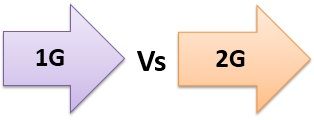 1G and 2G are the two generations of mobile phones. 1G is the first generation of mobile phones that brought first wireless communication to us. 1G uses an analog signal for communications and use FDMA for channelization. 1G is used for voice communication, data transmission service was not provided by 1G.
1G and 2G are the two generations of mobile phones. 1G is the first generation of mobile phones that brought first wireless communication to us. 1G uses an analog signal for communications and use FDMA for channelization. 1G is used for voice communication, data transmission service was not provided by 1G.
2G was digitalization of 1G i.e. it uses the digital signal for communication. 2G uses TDMA and CDMA for dividing the channels, and it provides voice plus data communication services. Lets us understand some more differences between 1G and 2G with the help of comparison chart shown below.
Content: 1G and 2G
Comparison Chart
| Basis for Comparison | 1G | 2G |
|---|---|---|
| Voice signals | Analog | Digital |
| Channelization Protocol | FDMA | TDMA, CDMA |
| Standards | MTS, AMTS, IMTS. | GSM. |
| Switching | Circuit Switching. | Circuit Switching and Packet Switching. |
| Service | 1G do not support data service. | 2G do not support complex data like videos. |
| Communication | 1G is first wireless communication. | 2G is digitization of 1G. |
| Internet | 1G do not provide the internet. | 2G provides narrowband internet service. |
| Drawback | Limited channel capacity, large phone size, low voice quality and low battery life. | Lack of network ranges and slow data rate. |
Definition of 1G
1G is the first generation of mobile phones which provides first wireless communication to the world. 1G uses the analog signal for voice communications. The 1G analog signal communication was introduced in the year 1980 and was used until it got replaced by 2G.
The method that 1G used for dividing the channel capacity is FDMA (Frequency Division Multiple Access). Each frequency retrieved using FDMA is used for the individual call. The switching used by 1g to allow voice communication is circuit switching.1G is built on the standards of MTS (Mobile Telephone System), AMPS (Advanced Mobile Phone System), IMTS (Improved Mobile Telephone System).
1G do not allow data transmission; it was only comfortable in voice communication, which is one of the important drawbacks of 1G. The other drawbacks that were limited channel capacity, unsecured communication, poor voice quality, poor battery life, large size of 1G mobile phones. These drawbacks were kept in mind while introducing 2G mobile phones.
Definition of 2G
2G is the second generation mobile phone that was introduced to replace 1G mobile phones in the year 1993 at Finland. 2G has overcome many drawbacks of 1G mobile phones and also introduced some new features along with that. 2G mobile phones used the digital signal for communication. Along with voice communication 2G allows data communication.
To divide the channel capacity, the 2Gmobile phones uses TDMA (Time Division Multiple Access) and CDMA (Code Division Multiple Access) methods. The switching technique used by 2G mobile phones are Circuit Switching and Packet Switching. 2G mobile phone were built on the standards of GSM (Global System for Mobile communications).
The 2G mobile phone allows narrowband internet. The 2G mobile phone required the strong digital signal to get worked so if there was a lack of network range digital signal become weak resulting in a non-working condition of mobile phones.
The other disadvantage that came forward while using 2G is that it couldn’t handle the complex type of data like videos. So to overcome the drawbacks of 2G, 3G was introduced later.
Key Differences Between 1G and 2G
- The basic difference that distinguishes 1G from 2G is that 1G uses analog signals while 2G uses the digital signal for communication.
- For accessing the channel method used by 1G is FDMA (frequency division multiple access). On the other hand, 2G uses TDMA (time division multiple access) and CDMA (code division multiple access).
- 1G was built upon the standards of MTS, AMTS, IMTS. While 2G was built upon the standards of GSM.
- Switching type used in 1G is circuit switching whereas, the switching type used in 2G is circuit switching and packet switching.
- 1G provide voice communication service but no data communication. On the other hand, 2G provide voice and data communication service, but it does not allow complex data communication like video.
- 1G provides the first wireless communication service whereas the 2G is digitalized version of 1G.
- 1G is unable to provide internet service whereas the 2G provide narrow band internet service.
- The drawbacks of 1G are limited channel capacity, the large size of the phones, low quality of voice and low battery life. On the other hand, the drawback of 2G is the slow rate of data transmission and low network ranges.
Conclusion
1G is the first and the oldest generation of mobile phone which was later replaced by 2G. 2G is the advanced (digital) version of 1G and has overcome many of the disadvantages of 1G.
Anas says
thanks for ur cooperation